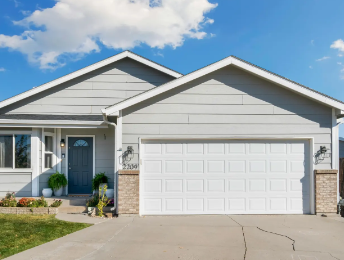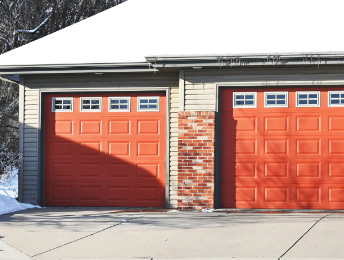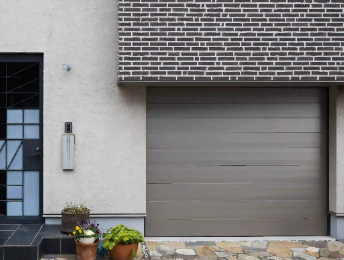How Extreme Weather Affects Your Garage Door and Ways to Protect It
Published: May 15, 2025
Your garage door deals with more direct exposure to the elements than almost any other part of your home. From high winds and driving rain to summer heat and freezing snow, it takes the hit every season. Most homeowners don’t think much about weatherproofing until problems show up—leaks, drafts, loud operation, or damage. Adding simple upgrades like garage door weather stripping can make your door last longer, perform better, and help you avoid costly repairs. Let’s go over the essentials to keep your garage door ready for any season.
The Impact of Extreme Weather on Your Garage Doors
Changing temperatures and seasons can affect your garage door’s performance. Heat may cause materials to swell or warp. Cold stiffens the springs and rollers, and moisture can lead to rust. All of this adds extra strain to the system and causes it to wear out faster than normal use alone.
How Temperature Changes Affect Garage Door Performance
Cold weather can cause springs to lose tension and lubricants to thicken, making the door harder to move. In the summer, garage door openers may overheat, and wood panels can crack or shift. These changes often happen gradually and may go unnoticed—until the door starts sticking, creaking, or moving unevenly.
Common weather-related garage door problems include:
- Rainwater leaking in at the base or corners
- Cold air sneaking through worn weather seals
- Rusted hardware from road salt or humidity
- Noisy or sluggish movement during operation
- Cracks or bowing in older wooden panels
When damage becomes frequent, it may be time to consider a garage door installation built with garage door weather seal technology in mind.
Top Ways to Protect Your Garage Door from Harsh Weather
Preventing damage doesn’t require a major renovation. Small changes make a real difference. This is especially true when applied before seasonal weather hits. Most protection focuses on keeping air, water, and debris out—and reducing the strain on moving parts.

Benefits of Proper Garage Door Weather Sealing
Installing or replacing garage door weather stripping offers several important advantages.
It helps keep your garage dry during storms, blocks cold drafts in the winter, and maintains stable temperatures year-round.
This added insulation can also lower heating and cooling bills, especially if your garage is attached to your home.
Beyond energy savings, sealing protects the door’s moving parts from dirt, moisture, and insects that can clog tracks or cause corrosion.
It also helps the opener run more smoothly and last longer by reducing outside noise and vibration.
Choosing the Right Garage Door Weather Seal
Not every seal fits every setup. Choosing the wrong one can leave gaps that let in wind, water, or pests.
- Bottom seals are the flexible rubber strips that attach to the base of the door. These are great for blocking out water and air where the garage floor isn’t perfectly level.
- Threshold seals are mounted on the garage floor and help redirect water runoff away from the entrance.
- Side and top seals close off the space between the door frame and the edges of the door, preventing drafts and insects from getting inside.

Homeowners often search for how to install garage door weather stripping, but it’s just as important to choose the right type of seal for your door material and local climate. If you’re planning to handle this yourself, you can follow our full guide on How to Install a Garage Door Weather Seal for step-by-step instructions and material tips.
Storm Season Checklist: How to Prep Your Garage Door
Storms can hit hard, especially in areas prone to high winds, heavy rain, or snow. If your garage door isn’t properly sealed and reinforced, these conditions can lead to leaks, mechanical failure, or interior damage. A few preventive measures before storm season help keep your garage door functional and your belongings protected.
Step-by-Step Guide for Homeowners
- Check the garage door weather stripping along the bottom for cracks or flattening that allow water or cold air in.
- Clean and lubricate tracks and rollers to avoid jamming.
- Inspect spring tension by lifting the door manually—it should hold midway without falling.
- Install reinforcement braces if your area sees high winds or hurricanes.
- Test the auto-reverse safety feature and backup battery if your opener has one.
- Clear debris from drains and door edges to keep water flowing away from the garage.
When to Upgrade to a Weather-Resistant Garage Door
There comes a point when sealing and repairs aren’t enough. If the door is difficult to open, noisy, or no longer able to withstand the elements, a replacement might make more sense. Newer models are designed for better insulation, improved strength, and quieter operation.

Residential vs. Commercial Garage Door Stripping: What’s the Difference?
While residential garage doors typically use soft rubber seals that are easy to install and replace, commercial setups require tougher materials. Commercial garage door weather stripping is built for frequent use and more extreme environments. These systems often include brush seals or thick vinyl strips designed to hold up under heavier traffic and temperature shifts.
If you’re unsure how to install garage door weather stripping on large doors or uneven concrete, it’s worth calling in a professional garage door company to make sure the seal is tight and long-lasting. A poor seal in a commercial setting can lead to energy loss, water damage, or pest issues—especially in warehouses or workspaces that rely on climate control.

Final Thoughts
Protecting your garage door doesn’t have to be complicated. Updating the garage door weather seal, inspecting hardware, and preparing for seasonal storms all play a role in extending the life of your system. When wear goes beyond quick fixes, upgrading to a better-sealed door may be the smartest option.
For clear answers and real support, Up & Down Garage Doors is here to provide honest advice and professional service. Feel free to reach out whenever you’re ready.


